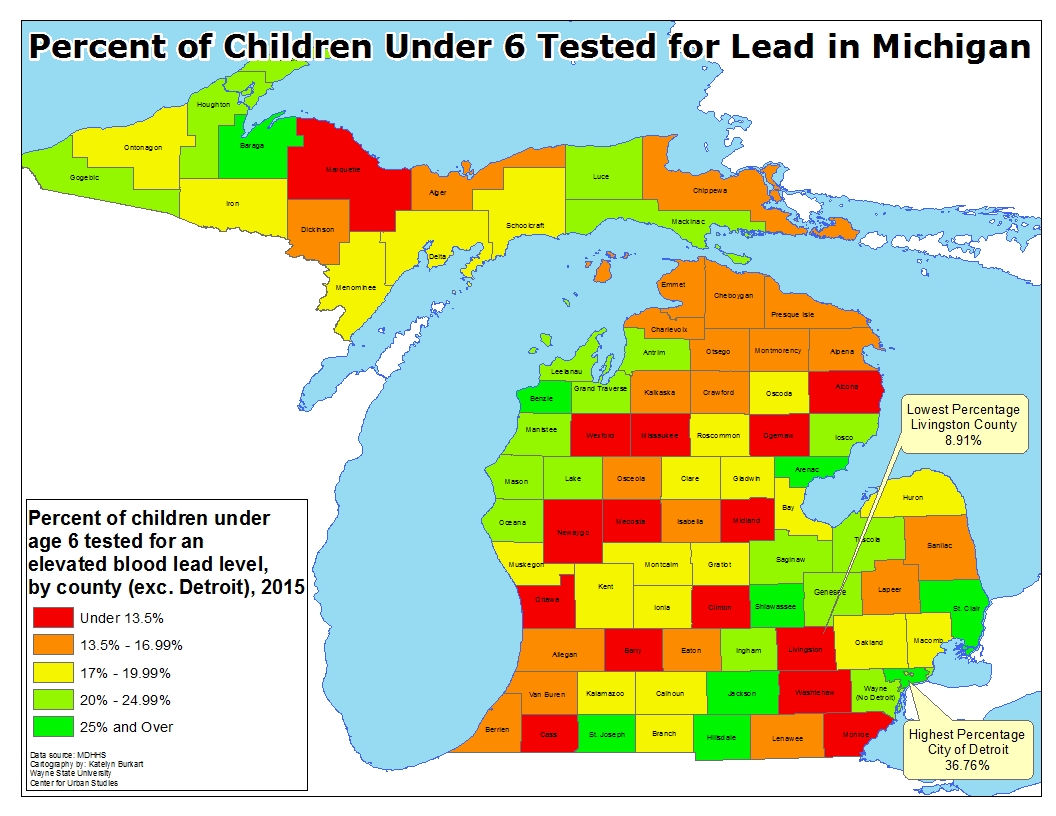In 2015 about 37 percent of children under the age of 6 in the city of Detroit were tested for an elevated blood lead level, according to data provided by the Michigan Department of Health and Human Services. This was the highest percentage of children tested in the state; Livingston County had the lowest percentage of children under the age of 6 tested at 8.91 percent.
As shown in an earlier post, we also saw that in 2015 Detroit had the highest percentage of children under the age of 6 with blood lead levels elevated above 5 ug/dL at 7.5 percent, according to the Michigan Department of Health and Human Services. Similarly, Livingston County had among the lowest percentage of its child population under the age of 6 tested for elevated blood lead levels while also having less than 2 percent of its child population test positive for elevated blood lead levels.
According to the Michigan Department of Health and Human Services, all children enrolled in Medicaid are considered to be at risk for lead poisoning. Michigan Medicaid Policy requires all children between the ages of 12 and 24 months ages be tested for elevated blood lead levels at least once. Additionally, a child between the ages of 36 and 72 months must be tested for blood lead levels if they have not been tested before. The 2015 data available for the number of children (ages 0-18) on Medicaid was not available for this post. However, we do know a child in Michigan is automatically referred to the state’s Medicaid program if their family’s income is at or below 150 percent of the Federal Poverty Level.
It is particularly important children at risk of lead poisoning be tested because the substance is absorbed more into a child’s body than an adults. Additionally, a child’s brain and nervous system is more sensitive to the damaging effects of lead. Babies and young children can also be more highly exposed to lead because they often put their hands and other objects that can have lead from dust or soil on them into their mouths.
Genesee County is where the city of Flint is located and in 2015 between 20 and 25 percent of Genesee County’s child population under the age of 6 was tested for elevated blood lead levels; more than 75 children under the age of 6 in just three zip codes within the city limits of Flint tested positive for elevated blood lead levels in 2015.
In response to the Flint Water Crisis, the State of Michigan has since “strongly recommended” that all children who live in the city, live in a home using Flint water or attend school or a childcare center in the city be tested for elevated blood lead levels. In addition, the state has required all children insured by Medicaid and/or enrolled in WIC be tested. These recommendations will certainly increase the percentage of children tested for elevated blood lead levels in Genesee County for the year of 2016.
Also, in a recent post we discussed how the city of Grand Rapids had one select zip code with 188 children under the age of 6 with elevated blood lead levels; in total there were no more than 523 children under the age of 6 in all of Grand Rapids with elevated blood lead levels. While the data on the percentage of children under the age of 6 tested for elevated blood lead levels in Grand Rapids in 2015 wasn’t readily available we do know that between 17 and 19.99 percent of children under the age of 6 in Kent County were tested for elevated blood lead levels.
The city of Adrian was another municipality discussed in a previous post because of the number of children with elevated blood lead levels. In 2015 there were 67 children under the age of 6 with elevated blood lead levels in Adrian, according to the Michigan Department of Health and Human Services. This number of children with elevated blood lead levels in Adrian contributed to the 10 percent of children under the age of 6 with elevated blood lead levels in Lenawee County. Subsequently, between 13.5 and 16.99 percent of children under the age of 6 were tested for elevated blood lead levels in 2015.
Although the areas mentioned above have been noted as having a high percentage of children under the age of 6 with elevated blood lead levels, none of the counties in which they are located in had more than 25 percent of children under the age of 6 tested for elevated blood lead levels. The counties in Michigan that did have more than 25 percent of its child population under the age of 6 tested for elevated blood lead levels were:
- Jackson County
- St. Clair County
- Shiawasee County
- Hillsdale County
- St. Joseph County
- Benzie County
- Baraga County
The map above shows that elevated blood lead testing throughout the state of Michigan is inconsistent and 15 counties throughout the state had less than 13.5 percent of its child population under the age of 6 tested for elevated blood lead levels. We also know that children living in poverty have a higher risk of being poisoned by lead, but as the map shows, not all children under the age of 6 are being tested for lead poisoning, and of those not being tested there is certainly a portion of at risk children being excluded.








